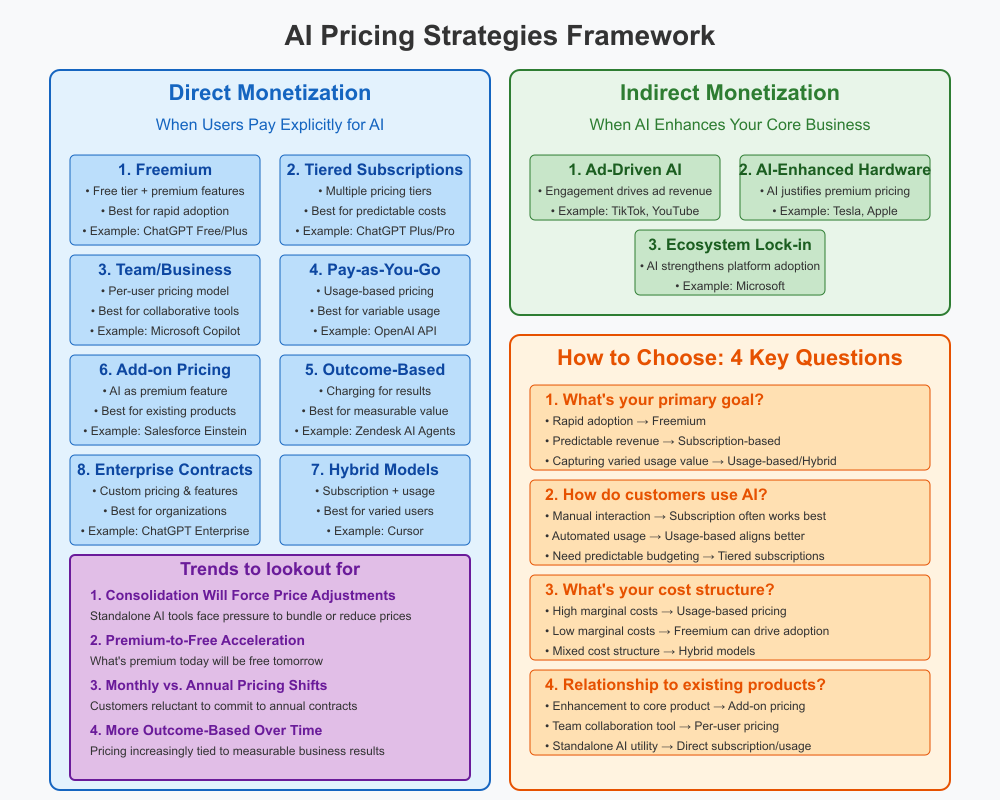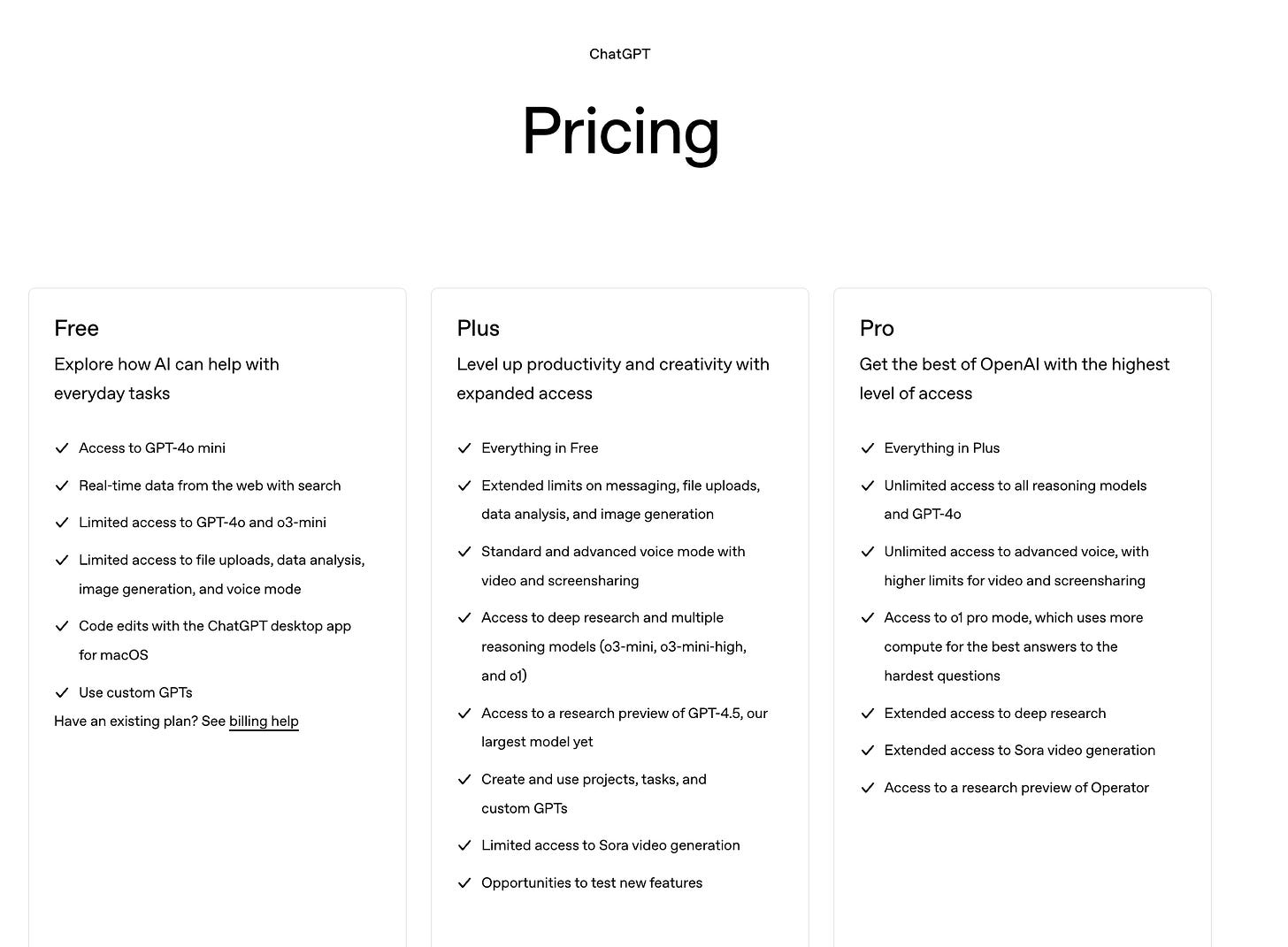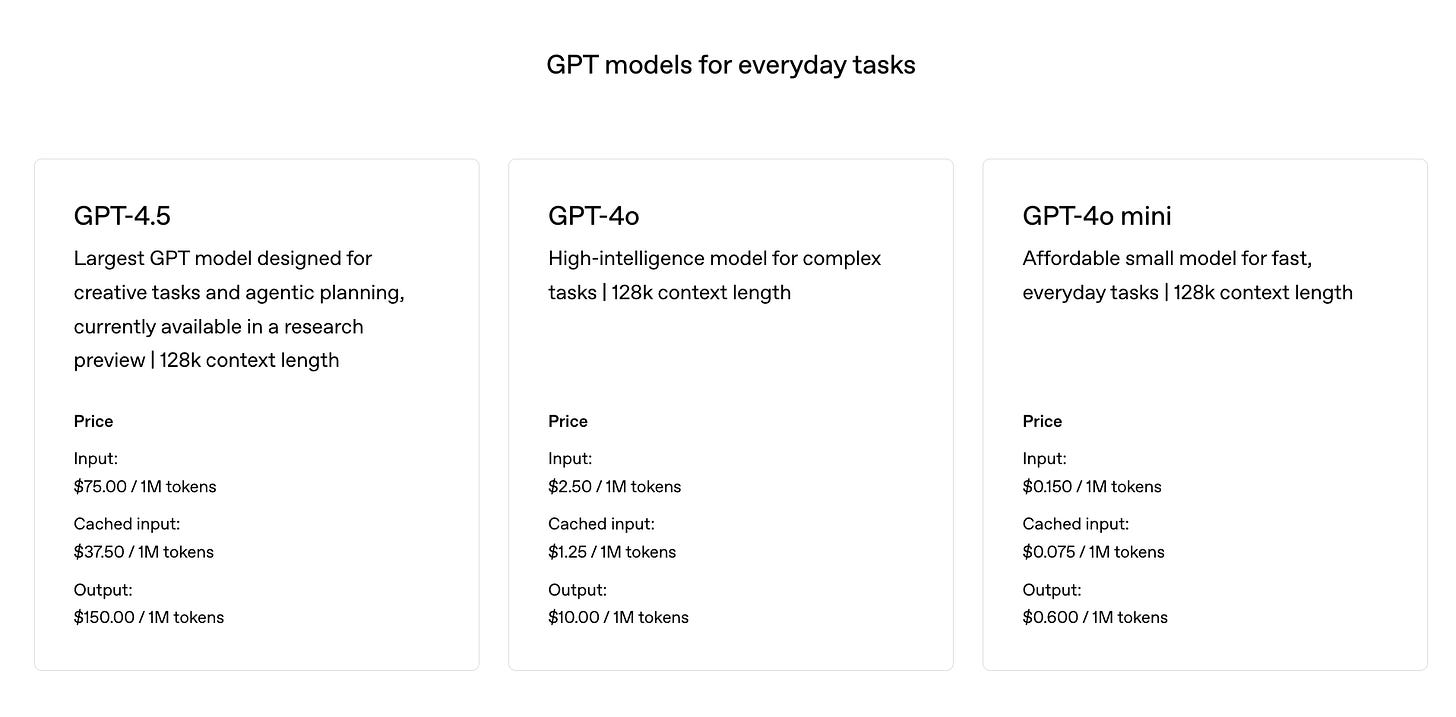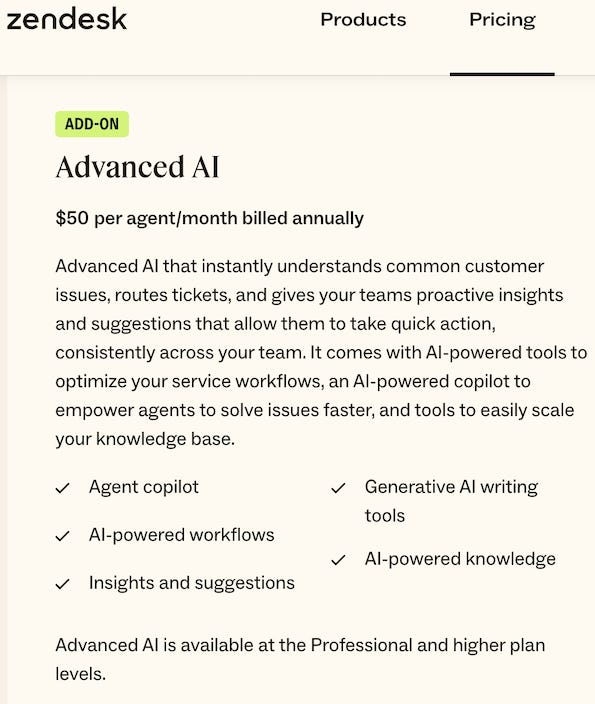The Product Manager's Guide to AI Pricing: Strategies That Actually Work
Proven strategies from analyzing today's top AI products
Ever notice how ChatGPT gives away powerful AI capabilities for free while Midjourney charges a premium? Or how OpenAI offers tiered pricing based on features while Microsoft's Copilot charges a flat $30 per user? Or even how some AI tools only offer monthly plans while others push heavily discounted annual commitments? The contrast is striking: some AI companies are building billion-dollar businesses while giving away their core technology, while others charge eye-watering amounts for seemingly similar capabilities.
If you're a product manager scratching your head about how to price your AI features or products, you're not alone. The traditional SaaS pricing playbook simply doesn't apply here.
So, what's the secret sauce behind successful AI monetization? What pricing models actually work? I've spent time analyzing the strategies of today's most impactful AI products, from consumer chatbots to enterprise solutions, and discovered patterns worth sharing. Let's break down the real business models powering the AI revolution.
The companies winning the AI race aren't just building better technology – they're crafting pricing strategies that match how people actually use AI.
The AI Pricing Playbook: Your Decision Framework
If you're building AI products, you essentially have two paths for monetization:
Direct Monetization: When Users Pay Explicitly for AI
These models charge users upfront or on a recurring basis:
1. Freemium: The Hook-and-Convert Approach
When it works best:
You need rapid, widespread adoption
Your product benefits from network effects
Your marginal costs for serving free users are manageable
Look at ChatGPT's strategy -- they offer enough value in their free tier to hook millions of users, then convert the power users to a $20/month Plus subscription. It's brilliant because the free tier creates massive brand awareness while the paid tier attracts users who hit the limitations of the free version. It's also strategically important because without the free option, there's a good chance that competitors would quickly capture market share.
The pitfall to avoid: If your compute costs are high, an overly generous free tier can bankrupt you. Generating images incurs much higher costs than generating text due to the greater compute complexity, GPU requirements, and memory needs. Midjourney cut back their free offerings and now offer only priced plans.
2. Tiered Subscriptions: Predictability Wins
When it works best:
Your AI costs are relatively predictable
Users value simplicity in budgeting
Your product is considered mission-critical
OpenAI's ChatGPT offers a perfect example of tiered subscription pricing. ChatGPT Free provides basic access, while ChatGPT Plus ($20/month) offers priority access, faster responses, and GPT-4o. For power users, ChatGPT Pro ($200/month) delivers higher usage limits, o1 Pro Mode, and advanced AI features.
The pitfall to avoid: If your AI delivers diminishing returns over time, subscription fatigue can lead to high churn. Your value proposition needs to consistently justify the recurring cost. Another important consideration is choosing between monthly versus annual pricing. With AI technology and leading players changing rapidly, consumers are increasingly wary about committing to year-long contracts, which explains why you're seeing more competitive monthly pricing options -- or in some cases, no annual options at all, as with ChatGPT.
3. Team/Business Subscriptions: Per-User Pricing
When it works best:
Your AI tool is designed for collaborative use across teams
Value scales with the number of users leveraging the technology
You need a straightforward scalable model for organizational adoption
Per-user pricing is the bread and butter of team-focused AI tools. Microsoft's 365 Copilot ($30/user/month) and Notion AI charge a flat rate per user per month, making it easy for organizations to calculate costs as teams grow. This model shines when the AI delivers individual productivity benefits that compound across teams.
The pitfall to avoid: If your AI provides system-wide benefits rather than per-user value, this model breaks down. For instance, one of the products I led was a sentiment classification product where the benefit of sentiment analysis was for the entire system and not for an individual user, hence charging per end-user would have felt disconnected from the value delivery.
4. Pay-as-You-Go/Consumption pricing: Aligning Cost with Value
When it works best:
Your AI costs scale directly with usage
Usage patterns vary widely among customers
You're targeting developers or technical users
OpenAI's per-token API pricing gives developers exact control over costs as they scale. No commitment required, but unlimited growth potential. This matters more as AI becomes a commodity. The "bring your own keys" (BYOK) trend is crucial - users want to use their AI access across multiple apps, making pay-as-you-go pricing the most sensible option.
Companies can choose to measure consumption in various ways. Some common factors used are:
API calls
Tokens processed
Compute time
Data volume
Query complexity
The pitfall to avoid: Revenue predictability suffers with this model. You'll need to build strong forecasting capabilities to manage your own costs effectively.
5. Outcome-Based Pricing: Charging for Results, Not Resources
When it works best:
Your AI delivers measurable business outcomes
Customers care more about results than how they're achieved
You're confident in your AI's ability to consistently deliver value
A close kin to consumption pricing, outcome-based pricing ties costs directly to the output value your AI creates, and not the input. Instead of charging for usage or access, you charge for specific results - customer queries answered, fraud detected, sales closed, efficiency gained, or costs reduced. Zendesk has an outcome-based pricing model where it measures real results delivered by AI agents, such as tickets closed. Several companies in healthcare are also experimenting with this, charging based on patient outcome improvements rather than just the AI technology itself.
This approach fundamentally aligns your incentives with your customers'. When they win, you win. It's the most direct way to demonstrate confidence in your solution and capture a fair share of the value you create.
The pitfall to avoid: Implementation complexity. You'll need robust measurement frameworks, customer agreements on what success looks like, and the ability to definitively attribute outcomes to your AI. Most companies start with hybrid models - a base subscription plus outcome-based components - as they work through these challenges.
As AI becomes a commodity, your pricing strategy becomes your most powerful differentiator.
6. Add-on Pricing: AI as a Premium Feature
When it works best:
You have an established product with a loyal customer base
Your AI capabilities enhance but aren't central to your core offering
You want to monetize AI without disrupting existing pricing structures
With add-on pricing, you keep your base product intact while offering AI capabilities as an optional extra. Take Salesforce's Einstein AI or Zendesk's Advanced AI Add-on -- instead of forcing AI into every subscription tier, they offer it as a separate add-on that customers can purchase based on their specific needs. This approach lets customers self-select into AI adoption without forcing it on everyone.
The pitfall to avoid: Positioning is crucial here. If your add-on feels disconnected from the core product or the value proposition isn't crystal clear, adoption will suffer. The add-on needs to feel like a natural extension, not an afterthought.
7. Hybrid Models: The Best of Both Worlds
When it works best:
You serve both casual and power users
Your base AI costs are fixed, but marginal costs increase with heavy usage
You want to balance predictable revenue with growth potential
Several AI products have adopted hybrid pricing, which is a strategic mix between subscription pricing and pay-per-usage pricing. Cursor (an AI coding assistant) offers a base subscription for standard access but charges extra for high-volume AI queries. This approach ensures a reliable revenue floor while capturing additional value from intensive users.
The pitfall to avoid: Complexity. If your pricing becomes too difficult to understand, you'll lose customers in the consideration phase.
8. Enterprise Contracts: The High-Touch Approach
When it works best:
Your AI requires customization for specific business needs
Security, compliance, and governance are major considerations
When you need a steady flow of revenue
Products like ChatGPT Enterprise and Claude for Enterprise succeed here because they address the unique requirements of organizational buyers -- data privacy controls, admin dashboards, and enhanced security that justify premium pricing.
The pitfall to avoid: Long sales cycles and customization requirements can drain resources if you're not prepared for enterprise selling.
Indirect Monetization: When AI Enhances Your Core Business
Not every AI product needs to charge directly for AI capabilities. Sometimes, the smartest strategy is using AI to strengthen your existing business model:
1. Ad-Driven AI: Engagement Translates to Revenue
Companies like YouTube and Meta don't charge for their recommendation algorithms or for AI summaries, but these AI systems maximize engagement time -- which directly impacts ad revenue. The better their AI performs, the longer users stay engaged, and the more ads they can serve.
2. AI-Enhanced Hardware: Premium Features Command Premium Prices
Apple and Tesla bake AI capabilities into their products, justifying higher price points. Tesla's self-driving features add thousands to a vehicle's price tag, while Apple's AI-powered features drive hardware upgrades and ecosystem lock-in.
3. Ecosystem Lock-in: AI as Strategic Moat
Microsoft integrates AI throughout its product ecosystem, strengthening platform adoption and retention even when the AI features themselves aren't directly monetized. The real value comes from keeping users within their broader product universe.
How to Choose the Right AI Pricing Model: 4 Key Questions
After helping dozens of companies figure this out, I've distilled the decision process to four essential questions:
1. What's your primary goal right now?
Need rapid adoption? → Consider freemium with a premium conversion path
Need predictable revenue? → Subscription-based pricing
Want to capture maximum value from varied usage? → Usage-based or hybrid pricing
Looking to monetize existing customers? → Add-on pricing might be your best bet
2. How do your customers actually use AI?
Do they interact manually (like with chatbots)? → Subscription often works best
Is usage automated (like API calls)? → Usage-based pricing aligns better
Do they need predictable budgeting? → Tiered subscriptions make sense
Does value accrue to individual users or at the system level? → This determines if per-user pricing makes sense
3. What's your cost structure?
High marginal costs per user? → Usage-based pricing helps manage profitability
Low marginal costs? → Freemium can drive massive adoption
Mixed cost structure? → Hybrid models provide flexibility
4. What's your relationship to existing products?
Enhancement to core product? → Add-on pricing lets you monetize without disruption
Team collaboration tool? → Per-user pricing aligns with organizational value
Standalone AI utility? → Direct subscription or usage-based models work best
The most successful AI products make paying for AI feel natural and worthwhile, not forced or arbitrary.
The Future of AI Pricing: Trends to Watch
1. Consolidation Will Force Price Adjustments
As competition intensifies, standalone AI tools will face pressure to either drop prices or bundle into larger platforms. We're already seeing this with smaller AI startups being acquired by platform companies.
2. The Premium-to-Free Acceleration is Speeding Up
What's premium today will be free tomorrow. The window between premium AI features and their commoditization is shrinking, putting pressure on companies to continuously innovate their AI capabilities and pricing models.
3. Monthly vs. Annual Pricing Strategies Are Shifting
With AI technology evolving so rapidly, customers are increasingly reluctant to commit to annual contracts. This is forcing companies to offer competitive monthly rates rather than heavily discounted annual plans.
4. Outcome-Based Pricing Will Mature
As measurement frameworks improve, more AI companies will shift from experimental outcome-based models to mainstream pricing tied to measurable business results.
The Bottom Line for Product Managers
As a product manager leading AI initiatives, your pricing strategy isn't just a financial decision -- it's a core product decision that will determine adoption, usage patterns, and ultimately your product's success.
The companies winning in AI aren't necessarily those with the most advanced technology, but those who have aligned their pricing model with:
How customers actually derive value from AI
Their own cost structure and business model
The competitive landscape they operate in
The most successful AI products make paying for AI feel natural and worthwhile, not forced or arbitrary. Whether you're building consumer apps, developer tools, or enterprise solutions, the right pricing model creates a virtuous cycle where customer success drives your business growth.
What AI pricing challenges are you facing with your products? Drop a comment below -- I'd love to hear about your AI pricing challenges in the comments below!
About the author: Hi, I'm Shrikant Varma! I'm an experienced Product Manager who has been building AI products and driving strategic product decisions for several years. If you found this article insightful, please like, subscribe, and share it with your network.






